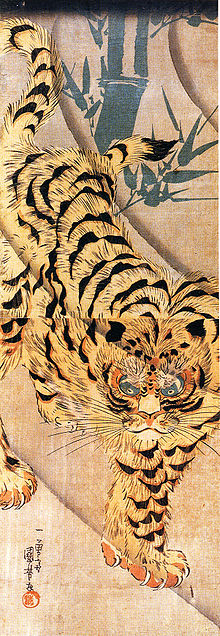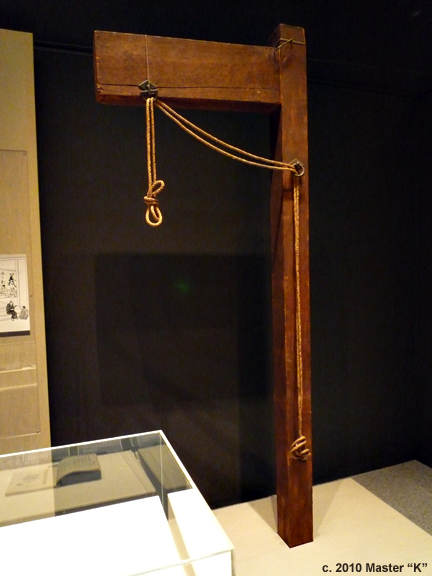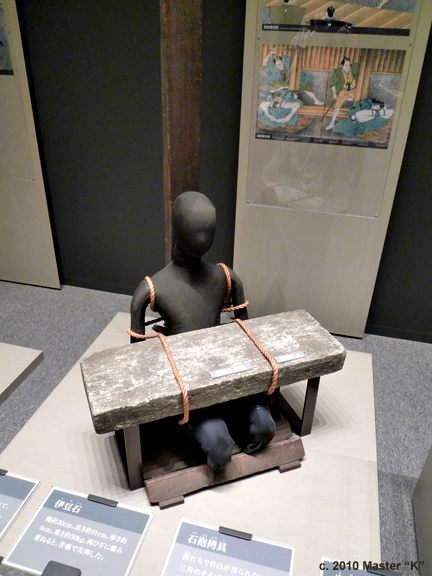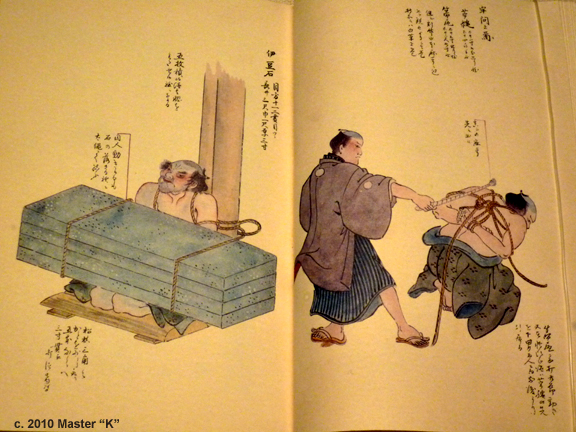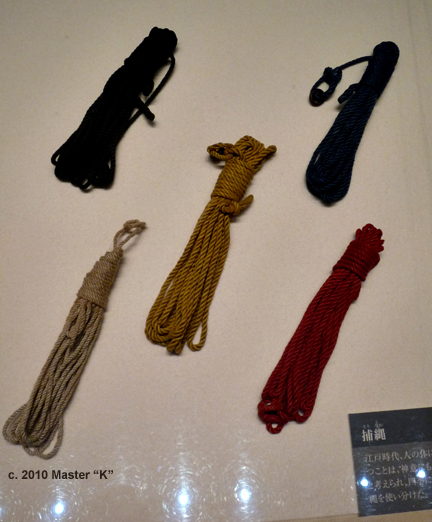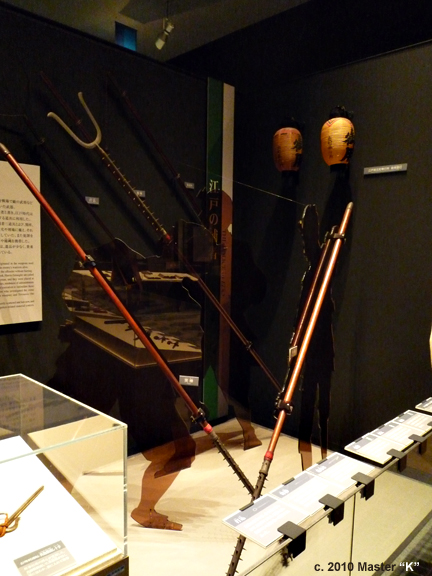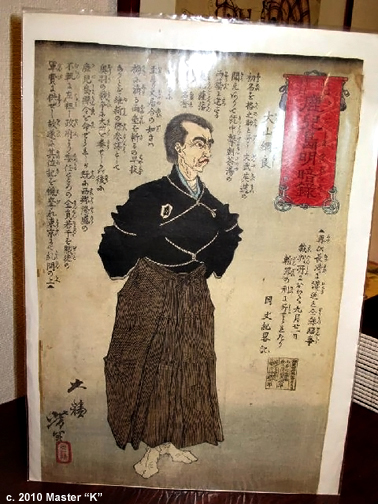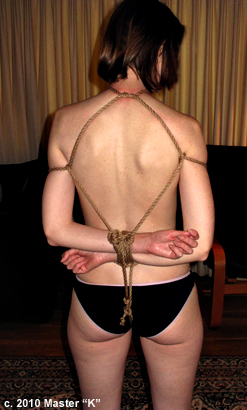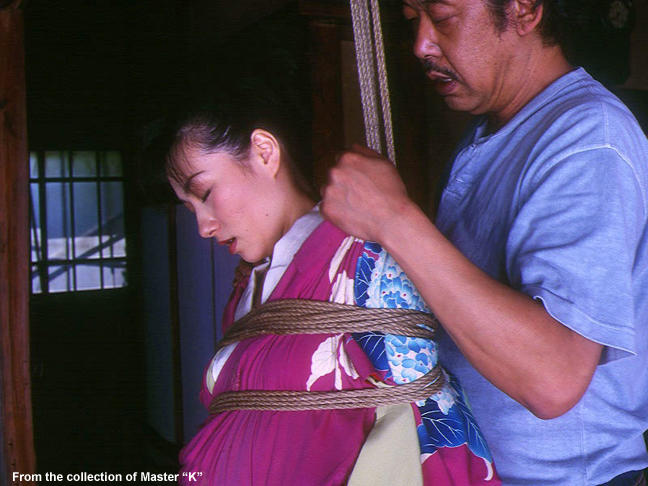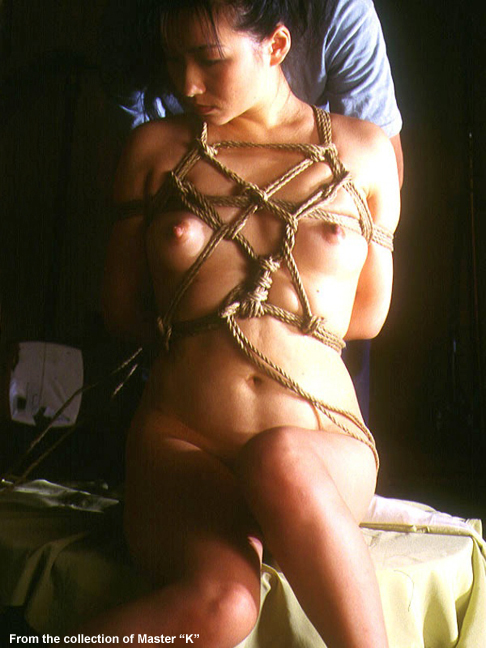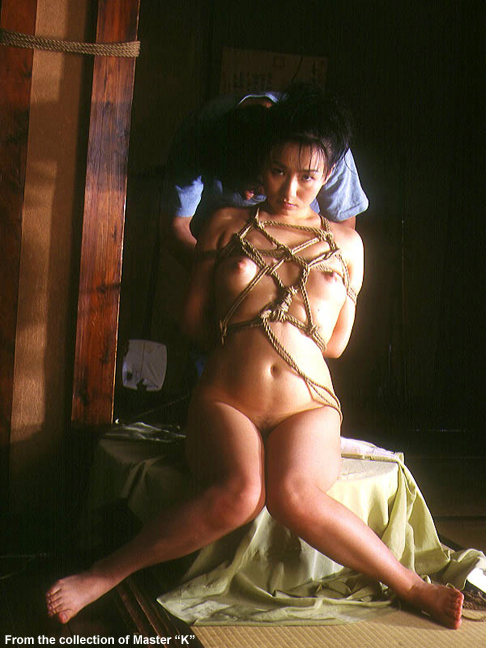The Beauty of Kinbaku
Or everything you always wanted to know about Japanese erotic bondage when you suddenly realized that you didn't speak Japanese
Meetings With Remarkable Men
A Trip to Japan - Meetings with Remarkable Men # 3a -
A lesson in newaza with Yukimura Haruki sensei
by Master "K"
For the kinbaku lover one of the most interesting aspects of a trip to Tokyo is the
The museum came instantly to mind as I entered Yukimura Haruki sensei's small but tidy apartment in a fashionable section of Tokyo on a warm but beautiful June day in order to take a lesson from the master. As I mentioned last time, this wonderful opportunity came about due to the generosity of Yukimura, who had been so kind in his comments about my book, and also due to my good friends Osada Steve and Nuit de Tokyo who were allowing me to take part in one of their tutorials. The subject was to be "newaza", the "caressing" style of kinbaku of which Yukimura sensei is the acknowledged living master.
However, it was clear as soon as I entered sensei's small tatami room cum kinbaku dojo that something else was in store, at least to begin with. It seems Steve had asked sensei to demonstrate for him some traditional "pattern" ties before class began and to my astonishment Yukimura was obliging by doing a classic hojojutsu style hishi pattern. However, unlike today's safety conscious versions, sensei was presenting the traditional style which utilized a potentially dangerous neck involvement. Sensei clearly explained the dangers but said this tie could be used effectively for closely controlled breath play given the appropriate partner and a very vigilant and experienced bakushi, such as Osada Steve.
It's a beautiful, deceptively simple and historic pattern and one I've seen before -- in the late 19th century prints of the great Ukiyo-e artist Yoshitoshi. He often used this tie for his "bondage" scenes and I'd long wondered if one version of this tie might not be the one used in his famous "Lonely House on Adechi Moor" picture with its striking pregnant woman suspension. I say this because in the "back only" version of the tie very little rope can be seen from the front because the pattern is often hidden by the subject's torso. Certainly it's this same pattern that's depicted in another well known Yoshitoshi print I have in my collection that shows a political prisoner.
As sensei explored this tie w/Osada Steve I was struck once again by how complex an art kinbaku is and how much study is needed to do it well and safely. Though deceptively simple, in the wrong inexperienced hands or done imprecisely, this tie could lead to disaster instead of to the dreamy look I saw on the face of Steve's beautiful and contented partner, clearly someone who enjoys a touch of safe, expert breath play w/their rope.
For instance, the great Tsujimura Takeshi (1921-1987?), one of the most famous bakushi of the 1950's -1970's was very adept at it but perhaps no one has made it their own in so complete a way as Yukimura sensei.
Osada Steve and Nuit have been fortunate enough to have been taking lessons for quite a while so it was very interesting to watch the first half of the lesson from the sidelines, so to speak, as Yukimura put Osada Steve and Nuit through their paces.
I should preface these comments by saying that I have always admired Osada Steve because not only is he a superb bakushi in his own right but he has also always been modest enough to want to learn more about his Art from others ... and when the others include Yukimura Haruki who can blame him? Still, this modesty and intelligent approach is often rare in doms, especially those from the West, and it deserves sincere praise.
Today's lesson was all about "putting more passion" into the newaza techniques and it was fun and instructive to see how each student did this. For those that have never seen the newaza style of kinbaku practiced let me offer a brief overview.
Newaza kinbaku is done with the bakushi kneeling behind the submissive so there is more physical contact then in other types of tying. This is why it is known as the "caressing style." In Yukimura's ryu (school) the tying motions are exact and must be executed precisely in order to have the desired effect on the submissive. The moves are bold and Yukimura sensei likes to use the word "sabaku" to describe them. This interesting word when taken as a verb describes the arm and hand movements of a fish carver, a most precise job to be sure. And when taken as a noun this same word means dessert, a fine double meaning for such a delicious technique.
Today Osada Steve and Nuit de Tokyo are continuing their months long lessons in 3 rope newaza whose purpose is to efficiently and beautifully bind and erotically stimulate their partner w/just 3 cords. Today that partner is a lovely young woman of 26 (or so) whose day job is being a nursery school teacher. Yukimura has many young women like this who want to work w/him, appear in his videos and assist in his lessons and if today's subject is any indication they all enjoy their employment.
After an hour of watching my 2 student colleagues expert and impressive progress it's finally my turn and as I position myself on the tatami mat it seems almost surreal that there beside me is the great bakushi Yukimura Haruki, my teacher! I'm happy to say my hands didn't shake ... but it was a close thing!
Fortunately, Yukimura is such a superb sensei and so kind in his approach to students that I feel quite confident that I'm doing OK as I pick up some vital elements of his unique style of kinbaku. Most importantly, as I work it becomes clear why Yukimura demands precision and I'm genuinely startled as to the effect a correctly done technique has on my partner as opposed to a bungled one. Fortunately I don't bungle too often! I even get the opportunity to try the hojojutsu hishi he demonstrated for Steve on my lovely Canadian-Japanese model and am delighted when she responds positively. As for the 3 rope newaza, I intend to practice what I've learned most diligently. It's the least I can offer my distinguished teacher by way of thanks.
Later I'm also shocked when I venture into an SM specialty shop in Kanda and see the same or similar Yukimura photos offered for sale for no less than $50 each! A most generous man to be sure.
I shall never forget this wonderful experience and the kindness of Steve and Nuit de Tokyo and, especially, Yukimura Haruki sensei who made me so welcome. I only hope to repay it someday and have the opportunity to learn more from this remarkable master.
Post script:
After returning to the US and much practice I hesitantly tried some of the newaza techniques I learned fromYukimura sensei in Japan on one of my stateside students. I wondered would a US sub's reaction be similar to the Japanese women I'd seen? Even admitting that the partner I chose was especially receptive to kinbaku the results were astonishing. Sub space in only seconds after I began. Powerful stuff this newaza! No wonder Yukimura sensei is held in such high regard in rope circles throughout the world!
More next time!
Join me for the next installment when Urado Hiroshi, the great Nikkatsu movie rigger, will be the subject of discussion.
Please note: no part of these articles may be reproduced by any means without the express written consent of the author or the publisher, King Cat Ink.
chance to visit the many sources of practical and historical information on the Art. Whether it's the famous SM Library or the rope shops or the specialty book stores in Kanda there's a lot to see.
However, no place is more important to an understanding of the origins of kinbaku than the Edo era criminal museum housed on the sprawling urban campus of Meiji University. Here authentic artifacts, valuable documents and clever reproductions and displays tell the story of crime fighting in feudal Tokyo (Edo) and by extension the story of hojojutsu, the martial art forerunner of modern day kinbaku. After studying this material no objective observer could doubt that most of what we've learned about safe, erotic rope had it's origins in this ferocious but fascinating centuries old martial art.
It's a well laid out and impressive museum and exhibit, one that benefited greatly from the addition (in the 1990's) of the Nawa Yumio collection of weapons and constable's equipment to its holdings. As some might know, Nawa Yumio (1912-2006) was one of the 20th centuries most influential Japanese martial art masters and authors who, once upon a time, contributed a series of influential articles on Edo era torture and restraint to the famous early SM magazine Uramado.
During my last visit to the museum I was honored to receive a guided tour given by one of its knowledgeable curators who allowed me to take the photographs included here.
To give the complete picture of this feudal pattern I add a photo of one of my own students in this tie, this time featuring the back view.
And then it was time for the real lesson to begin.
First, a definition:
Newaza - Floor techniques. Taken from martial arts such as judo, this useful term is used to describe shibari/kinbaku ties done principally on the tatami mat, as opposed to techniques used for suspensions (tsuri). In the right hands this style of shibari can be very sensuous and erotic.
In the right hands, indeed. No one living has a greater command of this powerful style of kinbaku than Yukimura Haruki. Of course, it must also be added that other famous bakushi have explored elements of this style over the years.
Perhaps this is because Yukimura's moto is "Tying is serving the woman." That is, finding the right approach to unlock each partner's needs and desires. It's no easy task and as I watch Steve and Nuit practice and respond to their sensei's gentle suggestions to "tighten here" or" maneuver the subject there" I'm struck by how detailed Yukimura sensei's instruction is. Each toss of the rope must be right, each move has a meaning and when combined with the details of creating Yukimura's specific takate-kote for use in newaza the whole process seems quite daunting!
As our lesson ends and I get set to head off to dinner w/Steve, I realize I've grown very fond of the charismatic Yukimura, a true gentleman and a brilliant bakushi who is most deserving of his fame. In keeping w/Japanese etiquette and tradition I offer him a small token of my appreciation for the precious lesson he's given me w/a gift brought from America. Sadly I take my leave but there's still one more suprise in store and I'm astonished to hear sensei clattering down the stairs to catch up to me in order to give a gift in return. It's a beautiful set of 10 kinbaku photos taken by Yukimura himself and packaged in a lovely Japanese box.
I'm touched beyond words.
